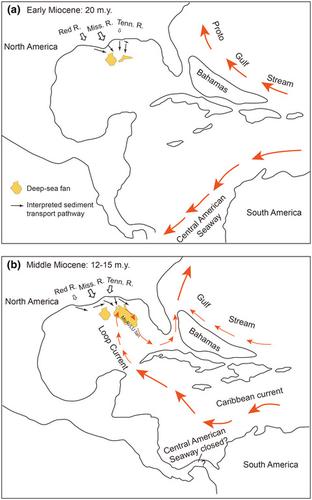当前位置:
X-MOL 学术
›
Basin Res.
›
论文详情
Our official English website, www.x-mol.net, welcomes your
feedback! (Note: you will need to create a separate account there.)
Quantifying the relative contributions of Miocene rivers to the deep Gulf of Mexico using detrital zircon geochronology: Implications for the evolution of Gulf Basin circulation and regional drainage
Basin Research ( IF 2.8 ) Pub Date : 2022-01-02 , DOI: 10.1111/bre.12653 Jie Xu 1, 2, 3 , John W. Snedden 3 , Fulthorpe S. Craig 3 , Daniel F. Stockli 2 , William E. Galloway 3 , Zachary T. Sickmann 3
Basin Research ( IF 2.8 ) Pub Date : 2022-01-02 , DOI: 10.1111/bre.12653 Jie Xu 1, 2, 3 , John W. Snedden 3 , Fulthorpe S. Craig 3 , Daniel F. Stockli 2 , William E. Galloway 3 , Zachary T. Sickmann 3
Affiliation

|
Sediment routing from hinterland to the deep sea is complicated because it involves evolution of river drainage from source areas to coastal plains and sediment mixing on the shelf and slope by marine currents. Previous regional paleogeographic mapping in the Gulf of Mexico (GOM) has observed a >150 km offset between the middle Miocene paleo-Tennessee fluvial axis and the associated deep-sea fan depositional axis, indicating a complicated sediment pathway. We integrate new and published detrital zircon (DZ) U-Pb age data from fluvial, shelf and deep-sea deposits to examine the complex Miocene sediment routing system in the northern GOM. These data suggest an increase in sediment load derived from western North America (increased Western Cordillera terranes; <300 Ma zircon age component) from the early to middle Miocene in the deep-water Green Canyon protraction area. The early Miocene Green Canyon area received sediments mainly from fluvial axes located directly updip: the paleo-Mississippi River (44%–56%; characterized by Yavapai-Mazatzal, Mid-Continent and Western Cordillera sourced 1800–1600 Ma, 1500–1300 Ma and <300 Ma, respectively, and Grenville-Appalachian sourced 1300–950 Ma and 500–300 Ma age components) and smaller rivers and tributaries draining the Appalachian Mountains (e.g. paleo-Tennessee River, 18%–43%; mainly Grenville-Appalachian sourced 1300–9500 Ma and 500–300 Ma age components). In contrast, the middle Miocene Green Canyon deep-sea fan shows a strong DZ signal from the paleo-Red River (38%; increased <300 Ma zircon age component), which requires input of additional sediment sources from west of the paleo-Mississippi system. In addition, the paleo-Tennessee River, which was a major middle-Miocene sediment source for the central-eastern GOM due to uplift and increased erosion of the Appalachian Mountains, is underrepresented (34%; decreased 1300–950 Ma zircon age component) in the middle Miocene Green Canyon fan. We suggest that two mechanisms combined to produce the increased middle Miocene input from western sediment sources and restriction of locally up-dip Tennessee River sources: (1) regional drainage changes involving middle Miocene capture of the paleo-Red River and its tributaries by the paleo-Mississippi River, which at the same time lost some of its eastern tributaries owing to expansion of the paleo-Tennessee and (2) eastward (clockwise) marine transport of western-sourced sediment along the shelf or slope, which deflected the paleo-Tennessee signal >150 km eastward to feed the deep-sea fan further east, perhaps reflecting intensification of a precursor to the GOM Loop Current.
中文翻译:

使用碎屑锆石年代学量化中新世河流对墨西哥湾深部的相对贡献:对海湾盆地环流和区域排水演化的影响
从腹地到深海的沉积物路线是复杂的,因为它涉及从源区到沿海平原的河流排水系统的演变以及海流在陆架和斜坡上的沉积物混合。先前在墨西哥湾 (GOM) 的区域古地理测绘观察到中新世古田纳西河流轴与相关的深海扇沉积轴之间的偏移 > 150 公里,表明沉积物路径复杂。我们整合了来自河流、陆架和深海沉积物的新的和已发表的碎屑锆石 (DZ) U-Pb 年龄数据,以检查 GOM 北部复杂的中新世沉积物路线系统。这些数据表明来自北美西部的沉积物负荷增加(增加的西部科迪勒拉地体;< 300 Ma 锆石年龄组分)深水绿峡谷延伸区早中新世。早中新世绿色峡谷地区的沉积物主要来自直接上倾的河流轴:古密西西比河(44%-56%;以亚瓦派-马萨扎尔、中大陆和西部科迪勒拉为特征,起源于 1800-1600 Ma、1500-1300 Ma和 <300 Ma,Grenville-Appalachian 来源于 1300-950 Ma 和 500-300 Ma 年龄成分)和流向阿巴拉契亚山脉的较小河流和支流(例如古田纳西河,18%-43%;主要是 Grenville-Appalachian来源 1300-9500 Ma 和 500-300 Ma 年龄组分)。相比之下,中新世绿色峡谷深海扇显示出来自古红河的强烈 DZ 信号(38%;增加了 <300 Ma 锆石年龄成分),这需要从古密西西比系统西部输入额外的沉积物来源。此外,由于阿巴拉契亚山脉的抬升和侵蚀加剧,古田纳西河是 GOM 中部中新世主要沉积物来源,其代表性不足(34%;1300-950 Ma 锆石年龄成分减少)在中新世绿色峡谷的中间扇。我们认为,两种机制相结合导致西部沉积物源增加中中新世输入和限制局部上倾田纳西河源:(1)区域排水变化涉及中中新世古红河及其支流被古捕获-密西西比河,
更新日期:2022-01-02
中文翻译:

使用碎屑锆石年代学量化中新世河流对墨西哥湾深部的相对贡献:对海湾盆地环流和区域排水演化的影响
从腹地到深海的沉积物路线是复杂的,因为它涉及从源区到沿海平原的河流排水系统的演变以及海流在陆架和斜坡上的沉积物混合。先前在墨西哥湾 (GOM) 的区域古地理测绘观察到中新世古田纳西河流轴与相关的深海扇沉积轴之间的偏移 > 150 公里,表明沉积物路径复杂。我们整合了来自河流、陆架和深海沉积物的新的和已发表的碎屑锆石 (DZ) U-Pb 年龄数据,以检查 GOM 北部复杂的中新世沉积物路线系统。这些数据表明来自北美西部的沉积物负荷增加(增加的西部科迪勒拉地体;< 300 Ma 锆石年龄组分)深水绿峡谷延伸区早中新世。早中新世绿色峡谷地区的沉积物主要来自直接上倾的河流轴:古密西西比河(44%-56%;以亚瓦派-马萨扎尔、中大陆和西部科迪勒拉为特征,起源于 1800-1600 Ma、1500-1300 Ma和 <300 Ma,Grenville-Appalachian 来源于 1300-950 Ma 和 500-300 Ma 年龄成分)和流向阿巴拉契亚山脉的较小河流和支流(例如古田纳西河,18%-43%;主要是 Grenville-Appalachian来源 1300-9500 Ma 和 500-300 Ma 年龄组分)。相比之下,中新世绿色峡谷深海扇显示出来自古红河的强烈 DZ 信号(38%;增加了 <300 Ma 锆石年龄成分),这需要从古密西西比系统西部输入额外的沉积物来源。此外,由于阿巴拉契亚山脉的抬升和侵蚀加剧,古田纳西河是 GOM 中部中新世主要沉积物来源,其代表性不足(34%;1300-950 Ma 锆石年龄成分减少)在中新世绿色峡谷的中间扇。我们认为,两种机制相结合导致西部沉积物源增加中中新世输入和限制局部上倾田纳西河源:(1)区域排水变化涉及中中新世古红河及其支流被古捕获-密西西比河,











































 京公网安备 11010802027423号
京公网安备 11010802027423号